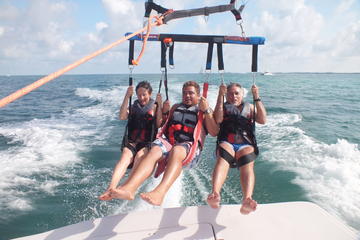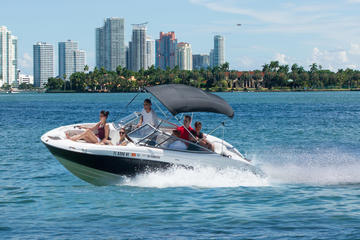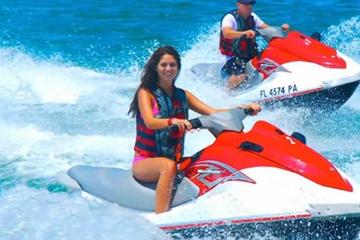Biscayne National Park
Biscayne National Park, about 15 miles south of Miami, protects an extensive mangrove forest (including the endangered species inhabiting it such as the manatee), the first island in the Florida Keys (Elliott Key), and the northernmost region of the Florida Reef, one of the largest coral reefs in the world.
Biscayne Bay itself is a shallow lagoon inhabited by manatees, bottlenose dolphins and many diving birds. Elliott Key is the largest island in the park and is the home to the semaphore prickly-pear cactus, one of the rarest plants in the United States, and breeding grounds for loggerhead turtles.
Except for the Visitor Center, the National Park is best seen and explored by boat. Despite this limitation, more than half a million people use the park annually. Snorkeling and scuba diving the reef and shipwrecks are popular. Sailing, windsurfing, kayaking and fishing are also popular. The peak season for visits to Biscayne Bay is during the winter from January to April.
Open / Close / Reopening Status of Biscayne National Park due to Coronavirus (COVID-19)
Please check the national park website for the latest information.
Last Updated: June 12, 2021
History
The human history of Biscayne extends about 10,000 years. Nearly every island in the park has some evidence of use by native peoples, before the sea level rose to present levels, and shipwrecks from across the ages sit underwater. There are more than 40 known shipwrecks within the park boundaries. Farming was attempted in the 19th and early 20th centuries, but the rocky soil and seasonal hurricanes made it a difficult industry to sustain. The islands became a destination for wealthy families from Miami, including Mark C Honeywell’s retreat on Boca Chita Key.
Initially, Biscayne Bay was part of the plans for Everglades National Park, but was excluded to ensure the creation of Everglades. It remained undeveloped and unprotected until the 1960s, when seaport and refinery/petrochemical facilities were planned for the shore, as well as plans to develop them like Miami Beach. Two fossil-fueled power plants and two nuclear power plants were built there, and the backlash against this development lead to the federal designation of National Monument in 1968. The protected land was expanded and in 1980, it was redesignated as Biscayne National Park.
The park’s visitor center is on the mainland, but the park, both land and sea, is only accessibly by boat. About 95% of the park’s 173,000 acres is comprised of water. There are four ecosystems in the park: the mangrove swamp along the shore, the shallow waters in Biscayne Bay, the coral limestone keys, and the Florida Reef offshore. The area is home to a variety of fish, seagrass beds, sponges, corals, and manatees. Tropical vegetation including endangered species are found there, and they provide nesting grounds for endangered sea turtles. The offshore water, including the reef, harbor more than 200 species of fish, birds, whales, and hard corals. Overall, sixteen species of endangered species are found in the park, as well as a small population of threatened American crocodiles and alligators.
Entrance fees
Entrance to Biscayne National Park is free, however since only the visitor’s center is located on the mainland, accessing the rest of the park may require fees such as boat rentals or a tour, if you don’t have access to transportation of your own. There are also fees for camping (which include docking fees for those using their own boats).
Busiest Months (Percentage of Annual Visits)
Dante Fascell Visitor Center
The Visitor Center is one of the few areas of the park accessible without a boat. It is nine miles east of Homestead at Convoy Point.
The visitor center has a museum offering a virtual tour through the park’s ecosystems, films to learn about the park, a gallery of local artists and a touch table with bones for kids to feel. Guided boat tours depart from the visitor center on select Thursdays, Fridays, Saturdays and Sundays. The cost is $21-$31 plus tax for the three hour tour including exploration of Boca Chita Key and the park’s historic lighthouse.
Island Dreamer Sailing also offers full day sailing trips departing from visitor center. There are also several nearby marinas where visitors can depart on authorized commercial operations for boat tours, snorkeling, scuba diving, fishing and other maritime activities.
Near the visitor center is Homestead Bayfront Park, which is operated by Miami Dade County. The park includes a marina, boat ramp, beach, natural atoll pool, and fishing pier, among other things.
Birding:
The birds in the national park as either common or abundant by the National Park Service include: American Coot, American Kestrel, American Redstart, Barn Swallow, Belted Kingfisher, Black Skimmer, Black Vulture, Black-and-white Warbler, Black-bellied Plover, Black-throated Blue Warbler, Black-whiskered Vireo, Blackpoll Warbler, Blue-gray Gnatcatcher, Boat-tailed Grackle, Bobolink, Brown Pelican, Cape May Warbler, Cattle Egret, Chuck-will’s-widow, Common Grackle, Common Yellowthroat, Double-crested Cormorant, Eastern Screech-Owl, European Starling, Gray Catbird, Gray Kingbird, Great Blue Heron, Great White Heron, Great Crested Flycatcher, Great Egret, Green Heron, Herring Gull, Indigo Bunting, Killdeer, Laughing Gull, Least Sandpiper, Least Tern, Little Blue Heron, Magnificent Frigatebird, Mourning Dove, Northern Cardinal, Northern Gannet, Northern Mockingbird, Northern Parula, Northern Waterthrush, Osprey, Ovenbird, Palm Warbler, Western Palm Warbler, Peregrine Falcon, Prairie Warbler, Red breasted Merganser, Red-bellied Woodpecker, Red-eyed Vireo, Red-shouldered Hawk, Red-winged Blackbird, Ring-billed Gull, Royal Tern, Ruddy Turnstone, Sanderling, Semipalmated Plover, Sharp-shinned Hawk, Short-billed Dowitcher, Snowy Egret, Sooty Tern, Spotted Sandpiper, Tricolored Heron, Turkey Vulture, White Ibis, White-crowned Pigeon, White-eyed Vireo, Willet, Worm-eating Warbler, Yellow-crowned Night-Heron, and Yellow-rumped Warbler.
Recent Bird Sightings
Weather:
Average Temperature (Monthly)
Radar:
Forecast:
[wunderground location=”Miami, FL” numdays=”4″ layout=”simple” showdata=”search,alert,daynames,highlow,pop,icon,text,conditions,date”]
Some Hotels and Other Lodging Options:
Biscayne National Park Camping
There are campgrounds on Boca Chita Key and Elliott Key. Boca Chita is the park’s most popular island and Elliott is the park’s largest island. The normal camping fee is $25 per night which includes a tent site and boat docking. There is also a group campsite on Elliott Key with a maximum of thirty people and five tents.
Roundtrip Flights to Miami:
[tp_in_our_city_fly_shortcodes destination=MIA title=”” limit=15 paginate=false stops=1 one_way=false off_title=true subid=”” currency=”USD”]
Vacation Packages:
Do you need to book in advance to visit Boca Chita Key?
Biscayne National Park Institute runs day trips to Boca Chita Key. Advance reservations are recommended but trips can be booked on the day of at the park when space is available. If you have your own boat, availability for the marina docking is first come, first served.
Does Biscayne National Park have a beach?
There is a beach at a swimming lagoon next door to the Biscayne visitor center at Homestead Bayfront Park. The admission there is $5-7 per car. Swimming is allowed at Boca Chita Key but not in the harbor, the no wake zone or designated areas to protect wildlife. There is a small beach there. There is also a swimming area in Biscayne National Park at Elliott Key (although we can not say whether either Boca Chita or Elliott is actually a beach).
What is the average depth of Biscayne Bay?
The average depth of Biscayne Bay is between six and ten feet. It had been lower historically but dredging has made the bay deeper.
Are there dolphins in Biscayne Bay?
The Atlantic Bottlenose Dolphin is found in Biscayne Bay.
Everglades National Park
Anhinga Trail
Everglades Camping
Everglades History
Everglades Weather
Flamingo
Hiking Trails
Nine Mile Pond
Pahayokee Overlook
Shark Valley
Shark Valley Tram Tour
Dry Tortugas National Park
Birds of the Dry Tortugas
Dry Tortugas Camping
Dry Tortugas Fishing
Dry Tortugas Ferry
Dry Tortugas Kayaking
Dry Tortugas Seaplane
Dry Tortugas Weather
Fort Jefferson Visitor Center
Key West
Loggerhead Key
Sea Turtles of Dry Tortugas
Snorkeling Dry Tortugas





